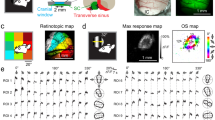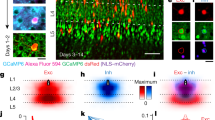Abstract
Neurones in the visual cortex are highly selective for orientation1 and spatial frequency2,3 of visual stimuli. There is strong neurophy-siological evidence that orientation selectivity is enhanced by inhibitory interconnections between columns in the cortex which have different orientation sensitivities4–6, an idea which is supported by experiments using neuropharmacological manipulation7,8 or complex visual stimuli6. It has also been proposed that selectivity for spatial frequency is mediated in part by a similar mechanism to that for orientation, although evidence for this is based on special use of visual stimuli, which hampers interpretation of the findings9,10. We have therefore examined selectivity for both orientation and spatial frequency using a technique which allows direct inferences about inhibitory processes. Our method uses microiontophoresis of an excitatory amino acid to elevate maintained discharge of single neurones in the visual cortex. We then present visual stimuli both within and outside the range of orientations and spatial frequencies which cause a cell to respond with increased discharge. Our results show that orientations presented on either side of the responsive range usually produce clear suppression of maintained discharge. In marked contrast, spatial frequencies shown to either side of the responsive range have little or no effect on maintained activity. We conclude that there is an intracortical organization of inhibitory connections between cells tuned to different orientations but not different spatial frequencies.
This is a preview of subscription content, access via your institution
Access options
Subscribe to this journal
Receive 51 print issues and online access
$199.00 per year
only $3.90 per issue
Buy this article
- Purchase on Springer Link
- Instant access to full article PDF
Prices may be subject to local taxes which are calculated during checkout
Similar content being viewed by others
References
Hubel, D. H. & Wiesel, T. N. J. Physiol., Land. 160, 106–154 (1962).
Campbell, F. W., Cooper, G. F. & Enroth-Cugell, C. J. Physiol., Lond. 203, 223–235 (1969).
Maffei, L. & Fiorentini, A. Vision Res. 16, 1255–1267 (1973).
Benevento, L. A., Creutzfeldt, O. D. & Kuhnt, V. Nature new Biol. 238, 124–126 (1972).
Creutzfeldt, O. D., Kuhnt, U. & Benevento, L. A. Expl Brain Res. 21, 251–274 (1974).
Morrone, M. C., Burr, D. C. & Maffei, L. Proc. R. Soc. B216, 335–354 (1982).
Sillito, A. M. J. Physiol., Lond. 250, 305–329 (1975); 289, 33–53 (1979).
Sillito, A. M., Kemp, A., Milson, J. A. & Berardi, N. Brain Res. 194, 517–520 (1980).
DeValois, K. K. & Tootell, R. B. H. J. Physiol., Lond. 336, 359–376 (1983).
Bonds, A. B. Invest. Ophthal. vis. Sci. 24, 229 (1983).
Ramoa, A. S., Freeman, R. D. & Macy, A. J. Neurophysiol. 54, 61–72 (1985).
Hubel, D. H. & Wiesel, T. N. J. Neurophysiol. 28, 229–289 (1965).
Gilbert, C. D. J. Physiol., Lond. 268, 391–421 (1977).
Pettigrew, J. D., Nikara, T. & Bishop, P. O. Expl Brain Res. 6, 373–390 (1968).
Author information
Authors and Affiliations
Rights and permissions
About this article
Cite this article
Ramoa, A., Shadlen, M., Skottun, B. et al. A comparison of inhibition in orientation and spatial frequency selectivity of cat visual cortex. Nature 321, 237–239 (1986). https://doi.org/10.1038/321237a0
Received:
Accepted:
Issue Date:
DOI: https://doi.org/10.1038/321237a0
This article is cited by
-
Emergence of orientation-selective inhibition in the primary visual cortex: a Bayes–Markov computational model
Biological Cybernetics (2004)
-
Subtractive and divisive adaptation in the human visual system
Nature (1992)
-
The relationship between the Gabor elementary function and a stochastic model of the inter-spike interval distribution in the responses of visual cortex neurons
Biological Cybernetics (1992)
-
Inhibition contributes to orientation selectivity in visual cortex of cat
Nature (1988)
-
A model of striate response properties based on geniculate anisotropies
Biological Cybernetics (1987)
Comments
By submitting a comment you agree to abide by our Terms and Community Guidelines. If you find something abusive or that does not comply with our terms or guidelines please flag it as inappropriate.



